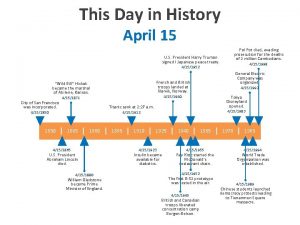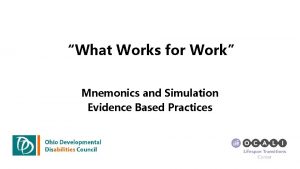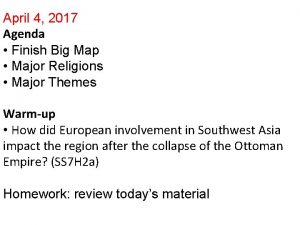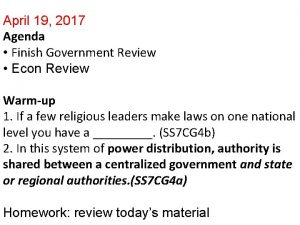April 6 2017 Agenda Finish History of SWA












- Slides: 12

April 6, 2017 Agenda • Finish History of SWA • History of Africa • Review quiz Warm-up 1. After the Ottoman Empire was defeated, what happened to most of its former territory? (SS 7 H 2 a) 2. What Arab region was the land Jews had lived in almost 2, 000 years ago and came under British control after WWI? (SS 7 H 2 b) Homework: review today’s material

1. It was divided between France and Great Britain using artificial borders 2. Palestine

Milestone Unit: Milestone Review 1. 7 thgrade Standards 2. Big Map 3. Warmup (4/3 – 4/7) 4. Major Religions 5. Major Themes 6. Important People 7. History of SWA 8. History of Africa 9. Gov. Terms 10. Gov. Systems

a. Explain how the European partitioning across Africa contributed to conflict, civil war, and artificial political boundaries. decisions made by European colonial powers in Africa, during the 1800 s and 1900 s, have influenced African countries of the 21 st century. opartition, colonial rule, political boundaries, and civil war have played out differently in a variety of countries o. Europeans partitioned Africa and the consequences of that action is the created tension and instability in Africa. 1. In 1946 British colonial authorities merged southern and northern Sudan into a single administrative region. The inhabitants of southern Sudan primarily practice Christianity and Traditional African religions. Northern Sudan is inhabited by Arab Muslims. Merging the citizens in the previously separate regions led to the first Sudanese civil war and subsequent political and ethnical strife. Based on the passage, what contributed to civil war in Sudan? A. Apartheid. B. Pan-African Movement. C. Artificial political borders. D. African Nationalist movement.

b. Explain how nationalism led to independence in South Africa, Kenya, and Nigeria. • In some parts of Africa, the people ruled by European colonial powers began to develop a strong sense of nationalism. This nationalism helped some countries in Africa become independent. • South Africa • Much of the colonial conflict in South Africa occurred between the British and the settlers of Dutch, German, and French origin who preceded the British. Eventually, the British Empire was able to consolidate power over this group and established the Union of South Africa in 1910. At this time, all power remained in the hands of white South Africans under British rule. In 1912, the African National Congress was established. This group of would fight for the rights of black and “colored” people in South Africa from 1912 through the end of Apartheid and the election of Nelson Mandela in 1994. It is important to understand that the independence of South Africa from the British Empire was established by the white minority in 1961. Their decision to declare themselves a republic was driven by their desire to maintain the system of Apartheid. The nationalist movement in South Africa did not achieve independence from a colonial power; rather, it defeated the Apartheid system and established equal rights for black and “colored” South Africans. • Kenya • Although there was a European presence in this part of Africa as early as 1498, Kenya did not become an official British colony until 1920. Black people in the colony were denied a role in politics until 1944, when a few black people were allowed to run and hold office. In the 1950 s, there was a violent, seven year uprising resulting in the deaths of tens of thousands of black Kenyans. Black participation in government increased steadily during this period, and Kenya became an independent nation in 1963. • Nigeria • British influence in Nigeria began in 1885 and the territory officially became a British colony in 1914. A largely peaceful nationalist movement in Nigeria led the British to move Nigeria gradually toward independence between 1945 and 1960. Final independence was achieved in 1960. Unfortunately, economic development by the British during the colonial period was unequally distributed in the territory that became the country of Nigeria. This allowed some of the ethnic groups in the country to have greater wealth and power than other ethnic groups. The inequities and ethnic tensions caused multiple coups throughout the 60 s, 70 s, 80 s, and 90 s.

2. Which of these was the result of the nationalist movement in countries like Nigeria and Kenya? a. poverty b. illiteracy c. independence d. the spread of AIDS 3. The independence movements in Kenya, South Africa, and Nigeria have which of the following in common? a. all gained independence in 1960 b. all gained independence from the British c. all followed the leadership of Jomo. Kenyatta d. all had to defeat the Boers 4. How do the independence movements in Kenya and Nigeria differ? a. one was a French colony while the was British b. Gandhi was the leader of the independence move in Kenya c. Nelson Mandela end colonial rule in Nigeria d. the independence movement violent in Kenya and peaceful in Nigeria 5. How did Nigeria’s diversity cause problems after independence? a. caused segregation of the races b. caused many political parties so the government was unable to make a decision c. caused all government paper work to be written in more than 400 languages d. caused ethnic and religious conflict that lead to civil war in 1966

d. Explain the impact of the Pan-African movement. Pan-Africanism–people of African descent, no matter where they lived in the world, should think of Africa as a homeland. They wanted to end European colonial rule in Africa and work together to make Africa better. Pan-African movement sparked many nationalist movements in Africa (which leads to independence) African Nationalism From 1900 to 1945, most Pan-Africanists, with the notable exception of Marcus Garvey, were black intellectuals from the United States, the Caribbean, and Europe or affluent black Africans studying abroad in Europe and the Americas. After WWII, these young black leaders began to organize influential groups of black Africans. Some of the groups attending Pan-African conferences in Europe developed nationalist movements in their colonies and fought for independence. Independence Some of the most influential Pan-Africanists rose to become president of newly independent African countries. This is true for Kenyatta in Kenya and Nkrumah in Ghana. The Pan-African movement led to the development of a loose organization of African states known as the African Union. 6. The purpose of the Pan African Movements in Africa is to A. Develop a unified region. B. Create one African language. C. Create one African Government. D. Develop a unified political identity. 7. The main goal of the Pan-African movement was to A. end any support for the African National Congress B. immediately overthrow all of the ruling governments in Africa C. get all African nations to become members of the United Nations D. get African to think of themselves as one people and work together

c. Explain the creation and end of apartheid in South Africa and the roles of Nelson Mandela and F. W. de Klerk. Apartheid –legal segregation of races in South Africa adopted in 1948; complicated system of racial identification and classifying citizens as either black, colored, Asian, or white. The Apartheid system greatly restricted the freedoms of non-white South Africans in many ways including • own little land • segregated facilities (schools, libraries, movie theaters, restaurants) • can’t marry someone of a different race • no voting or political freedoms The world reaction to this policy was strong; countries around the world criticized South Africa, boycotted South African made products, and the country was not allowed to participate in the Olympics. Nelson Mandela worked with the African National Congress to try to end Apartheid and was jailed for 27 years for his work against the government. In 1990, de Klerk began to repeal Apartheid laws as a response to the negative economic and political international pressure. De Klerk released Mandela from prison and Mandela and de Klerk had to work together to peacefully end Apartheid. Mandela and de Klerk were the leaders of two of the major political parties and wrote a new constitution guaranteeing all South Africans equal rights.

c. Explain the creation and end of apartheid in South Africa and the roles of Nelson Mandela and F. W. de Klerk. 8. What role did Nelson Mandela and F. W. De Klerk play in the evolution of Apartheid in South Africa? A. They created apartheid. B. They enhanced apartheid. C. They helped maintain apartheid. D. They worked to abolish apartheid. 10. A policy of racial segregation in South Africa, adopted in 1948, is called ____? A. Pan-Africanism B. Nationalism C. Imperialism D. Apartheid 9. What decision did South African President FW de Klerk eventually make about the country’s apartheid laws? A. He added many new and even harsher laws B. He began to recommend that the laws be repealed C. He lifted the segregation laws on those living in South African cities. D. He worked to spread apartheid laws to nations neighboring South Africa 11. Nelson Mandela and FW de Klerk won the Nobel Peace Prize in 1993 for ____. A. working for South Africa’s independence without violence B. the peaceful end of apartheid C. ending the ethnic fueled civil war in neighboring Angola D. surviving 7 thgrade social studies

Read through the information and make sure you can answer the questions correctly When you finish pick up the review quiz from the round table History Milestone Review

1. A 2. A 3. D or C 4. C 5. C 6. A 7. B 8. D 9. A 10. C 11. A 12. C 13. A 14. C 15. B 16. A 17. A 18. B 19. B Answers to History Review Quiz

Write question and your answer choice Daily Closing • The Israeli War of Independence (1948) and the Six. Day War (1967) have which of the following things in common? (SS 7 H 2 b) –Israel gained more land –Israel lost both wars –Israel fought Iraq both times –Israel lost control of Iran
 Gartner cio agenda 2018
Gartner cio agenda 2018 Agenda sistemica y agenda institucional
Agenda sistemica y agenda institucional This day in history april 15
This day in history april 15 April fools day in portugal
April fools day in portugal April 8th in history
April 8th in history Also history physical
Also history physical When william shakespeare born and died
When william shakespeare born and died William shakespeare 23 april
William shakespeare 23 april 30 days has september
30 days has september April school activities
April school activities April 26 1564
April 26 1564 April savoy allstate
April savoy allstate 8 day week
8 day week























